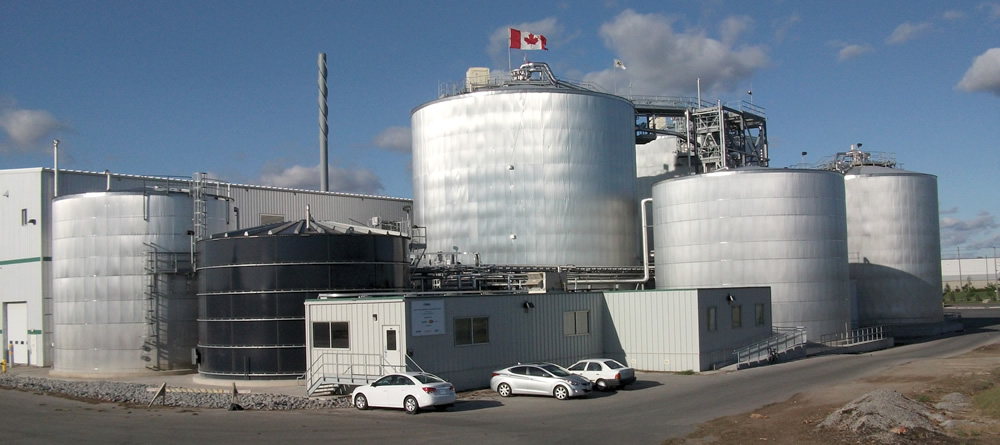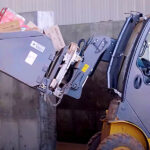Canada’s largest city started up its second digester to manage SSO collected from the residential sector, and is expanding capacity at its original facility.
Peter Gorrie
BioCycle February 2015
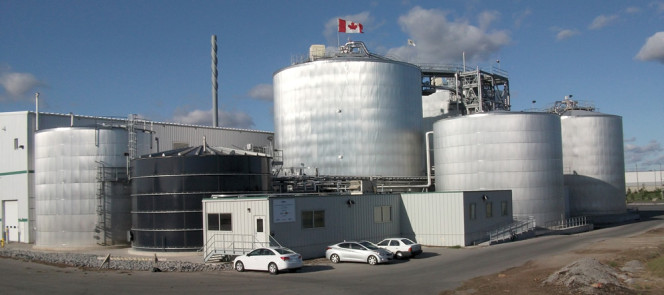
The City of Toronto’s new anaerobic digester, the Disco Road Organics Processing Facility, has capacity to process about 83,000 tons/year of residential source separated organics (SSO).
Photo courtesy of City of Toronto
Toronto, Ontario, Canada’s largest city, is taking major steps to expand its already successful collection and processing of residential source separated organic wastes. This spring, a ribbon cutting will mark the official opening of the City’s second organics processing facility, with pretreatment followed by anaerobic digestion (AD). Known as the Disco Road Organics Processing Facility, it is capable of handling up to about 83,000 tons of source separated organics (SSO) annually. Electricity generation and heat recovery will be added by spring of 2016.
Planning is underway to revamp and more than double the capacity of the city’s original SSO digester, the Dufferin Organics Processing Facility. The Dufferin plant opened as a pilot project 12 years ago, with capacity to process about 27,500 tons per year of SSO. When the expansion at Dufferin is completed, the two facilities combined will be able to process 143,300 tons of feedstock annually and Disco Road will produce enough electricity to be nearly independent of the provincial grid.
The $74 million Disco Road AD plant completed commissioning of its design and construction activities last summer. Following that step, the City of Toronto’s chief contractor, AECOM Inc., began implementation of operations, including establishment of biological equilibrium in the anaerobic digestion system, as well as optimizing and fine-tuning the wastewater treatment process, biofilter odor control system and biogas flare. With a municipal election last October, and the onset of winter, the City decided to schedule the official opening this spring, when the weather has improved and the new City Council is sitting.
The Disco Road project took advantage of lessons learned at the Dufferin site. While the fundamental process steps are similar, AECOM and operators Veolia North America and CCI BioEnergy Inc., “had the ability to build in all the good knowledge gained” at the pilot plant, says Carlyle Khan, the City of Toronto’s Solid Waste Management Services’ Director of Infrastructure Development and Asset Management.
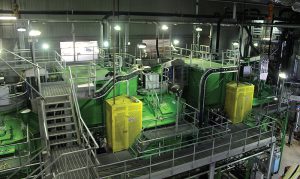
The organics, arriving in plastic bags and typically containing 12 to 14 percent
contaminants, are processed through one of three BTA Waste Pulpers. Centrifugal force opens the bags; contaminants separate into light and heavy fractions.
Photo courtesy of CCI Bioenergy, Inc.
Contaminant Removal
Similar to the original Dufferin facility, SSO is preprocessed through the BTA™ Hydromechanical Pretreatment System patented by Germany’s BTA International and licensed in Canada and the United States by CCI. Source separated organics from the tipping floor, typically containing 12 to 14 percent contaminants, are processed, 16.5 tons at a time, through one of three BTA Waste Pulpers. An impeller spins inside each of these Italian-made machines. The centrifugal force it creates breaks open the plastic bags in which Toronto residents put out their SSO, and separates the organic fraction from both light and heavy contaminants. Then, the impeller slows and the organic material is drawn out through a three-eighths-inch screen at the bottom of the waste pulper. The system captures 96 percent of the available digestible organics in the SSO, according to CCI.
Reclaimed process water is added to the pulper, causing lightweight contaminants to float to the surface. A rake-like mechanical arm drops into the tank and scoops them out for dewatering and disposal. Household batteries, meat bones, broken glass and other heavy contaminants sink to the bottom, from where they are rinsed and removed using a gate valve. The organic suspension goes to the BTA® Grit Removal System, where a hydrocyclone removes any grit in the organic suspension before it is sent to the anaerobic digestion phase.

Reclaimed process water is added to the pulper, causing lightweight contaminants, such as plastic bags, to float to the surface. A rake-like mechanical arm scoops them out.
Photo courtesy of CCI Bioenergy, Inc.
While Disco Road and Dufferin employ the same preprocessing system, efficiencies at the new site reduce the cycle times for each batch from about 120 minutes to 80. And new at Disco Road, the cleaned organic suspension goes into a 792,000-gallon (3,000-cubic-meter) buffer tank before being fed into the digester. This allows a continuous and consistent flow from the buffer tank into the digester 24 hours a day, seven days a week, even though the facility receives SSO only Monday through Friday during business hours. The result is a constant and efficient rate of biogas production.
Digestion And Post Processing
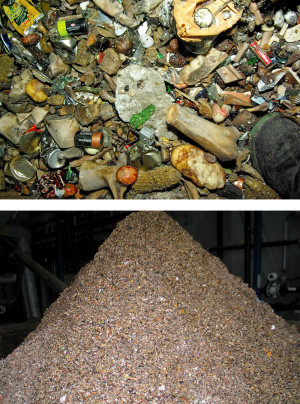
Household batteries, meat bones, broken glass and other heavy contaminants sink to the bottom; they are rinsed and removed (close-up contaminants, top and pile of grit shown, bottom).
Photos courtesy of CCI Bioenergy, Inc.
As at Dufferin, mixing is achieved inside the digester tank by compressing some of the biogas and pumping it through lines running deep down into the digesting material and letting it bubble back to the top. Both facilities produce about 110 cubic meters of biogas per ton of feedstock, says Neil MacDonald, Manager of Capital Delivery with the City’s Solid Waste Management Services.
At the back end, the Disco Road plant employs centrifuges rather than Dufferin’s less efficient screw press to remove water from the digestate before it is sent to All Treat Farms, two hours west of Toronto, to be mixed with yard trimmings and composted aerobically. Unlike the screw press, the centrifuges don’t require use of flocculent polymers to squeeze out the moisture. That alone saves up to $300,000 a year, notes CCI president Kevin Matthews, whose company provided the technology and manages the Disco Road facility for Veolia, which, in turn, is under AECOM.
The centrifuge produces digestate comprised of 30 percent solids, compared with just 26 to 28 percent from the screw press. The difference seems small, but the drier material is easier to handle and, since it is lighter, cuts transportation costs to All Treat Farms. The system is able to employ the centrifuge because almost all the contaminants have been removed at the start of the process, Matthews adds. “If you had a lot of junk in the digestate, you’d have trouble with the centrifuge.”
At the Disco Road plant, liquid digestate, rainwater, and all other water used on the site is collected and purified so that it can supply most of the facility’s water needs; any excess can be discharged into the City’s wastewater treatment system. The only fresh water required is a small amount for drinking and to clean instruments, Matthews says.
Another distinction between Dufferin and Disco is the degree of automation. “To operate this complex system, the new facility is far more automated than Dufferin was,” MacDonald explains. The automation provides many points for measuring temperatures, flow rates, feedstock composition, valve positions and other aspects of the system, with the ability to make alterations on the fly. “As a biological process it needs a lot of tweaking and adjustment to keep it in equilibrium,” he adds. With the computer controls, “we’re better able to adjust to variables.”
Biogas Utilization
More than 40 percent of the biogas generated at Disco is used to fuel boilers that produce heat for the digester tanks. The City plans to use a portion of the remaining biogas for what it calls the Disco Road Biogas Utilization Project, a cogeneration plant with two 1.4-megawatt generators. The generators will have enough capacity to supply most electricity demand at the site, which also includes a neighboring Works Yard. The city is in the process of applying for a Renewable Energy Approval, required for most biogas and other renewable energy projects in Ontario, and aims to have the cogeneration plant operating by spring of 2016. Any additional biogas would continue to be flared, as it is at Dufferin. Heat from the generator will provide space heating at the plant.
The City of Toronto explored options for recovering energy from a larger portion of the biogas, such as generating additional electricity to sell to the provincial grid, or upgrading the biogas to biomethane for sale to the natural gas pipeline grid or as a fuel for municipal vehicles. But those options are, for now, considered too expensive or speculative, or, in the case of selling electricity to the grid, bound up with provincial regulations.
Dufferin Upgrades
At the Dufferin site, a new digester tank and BioRem biofilter were installed between 2011 and 2013, without increasing the plant’s capacity. The coming revamp will boost it from 27,500 tons to 60,600 tons, retaining the new digester tank but installing a wastewater treatment system, expanding the biofilter, enlarging the tipping floor and space for processing equipment by 50 percent, installing a buffer tank, adding spill containment and making other upgrades.
The rebuild will retain the BTA process digestion system, and the city has prequalified two proprietary pretreatment technologies — the BTA process described above and another developed by Anaergia, located in Burlington, Ontario, which processes SSO in a hammer mill. A formal Request For Proposals has generated a lot of interest, “but since we’re in the RFP process, there’s not a lot we can share at this time,” says Khan. “Cogeneration isn’t included in the project scope today but that process will be managed similarly to that of Disco Road at the right time.”
Green Bin Expansion To Multifamily
On the collection side, the city is aggressively working to complete the rollout of the Green Bin program to its approximately 4,500 multiunit residential buildings. The program was launched in 2002 for all single-family residences and boasts a 90 percent participation rate. Almost all of the 1,700 smaller multiresidential buildings where curbside collection is possible are on the program and are using approximately 40-gallon (160-liter) carts for collection, says Annette Synowiec, the City’s Manager of Waste Management Planning. Larger, 2 cubic yard (1.6-cubic-meter) metal bins are being delivered to the city’s high-rise apartment and condominium buildings. The carts and bins for organics collection are provided at no cost along with in-unit kitchen catchers for residents to encourage participation in the program.
“It’s too soon to say how the Green Bin participation rate in multiunit buildings will compare with the 90 percent achieved in single-family homes,” Synowiec notes. Based on years of experience with Blue Bin recycling and also because separating organics is less convenient in high-rises, “it’s safe to say the rate won’t be as high as for single-family homes,” she adds. “But this is a new program and as it matures we’ll see the participation rate improve.”
Toronto has no plans to change its Green Bin rules, intended to minimize what’s referred to as the “yuck factor” by allowing residents to put their organics in conventional plastic bags and accepting materials such as pet wastes and disposable diapers. The City’s strategy aims to increase waste diversion, says Matthews, noting the BTA process is designed to remove a large variety of contaminants. “Participation is the determinant of success. If you can’t get it, you can’t process it. And if it’s not appealing or appetizing for people to play, they won’t. If you can get a wider swath of material to a processing facility that has the ability to separate organics from contaminants at a reasonable price, that gives you the highest result.”
Additional steps will follow as the city pursues an ambitious long-term waste management strategy (toronto.ca/wastestrategy), intended to establish policies to boost reduction, reuse, recycling and recovery of materials from all of its customers including residential and nonresidential sources for the next three to five decades. Toronto, with a population of 2.8 million, diverts 53 percent of all residential wastes from the landfill through Green Bin, Blue Bin, hazardous waste and other collection programs, and aims to improve that rate to 70 percent by 2016.
Curbside organics collection is now widely accepted — in fact, almost taken for granted — by residents of single-family homes. At present, collectors, a combination of City staff and private contractors, pick up about 112,000 tons each year from the residential sector. Organics that exceed the digesters’ capacity are trucked, under contract, to privately run aerobic composters. “The City’s target is to put in place infrastructure to manage 130,000 tonnes (143,300 tons) of organics diversion annually,” Khan says. The Disco Road Organics Processing Plant “is an integral part of that solution and will definitely satisfy our needs for several years to come.”
That combined throughput is based on preprocessing operations at both facilities running two shifts per day, five days a week, with a 15-day retention time for SSO in the digesters. “There might be potential to nominally increase throughput if necessary, subject to meeting approvals and compliance requirements,” Khan says. The City also has access to capacity for processing SSO at external contractor facilities.
The Long Term Waste Management Strategy study will map out Toronto’s future needs over the long term,Khan says.
Peter Gorrie is a Contributing Editor to BioCycle.


